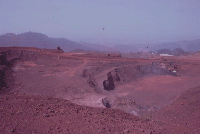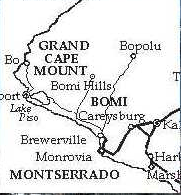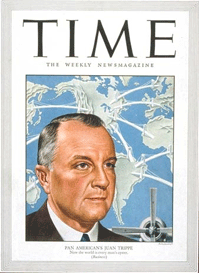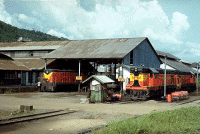|
Iron ore The start of operations of Liberia’s first iron ore mine |
|||||
|
|
|
|||||
|
The USA gets interested The truth behind the decision of the Barclay Administration to discontinue the relations with the NEEP for the exploitation of the Bomi Hills iron ore might be quite different. Reportedly, the cancellation of the concession agreement with NEEP was the result of pressure by the US State Department on President Edwin Barclay. The reasons for it are until now unknown. It may have been a coincidence but the following year the US State Department suggested to grant the right to further geological explorations in the Bomi Hills area to US Steel, a US owned steel company. The company sent a team to Liberia to investigate the possibilities, in 1938, but because of the absence of a harbor it gave up its rights. It is interesting to note that a certain Edward Stettinius was Chairman of US Steel in 1939 (see below). The outbreak of the Second World War postponed further progress with respect to the exploitation of the Bomi Hills iron ore reserves. When in 1943 President Barclay, accompanied by President-elect William Tubman, visited the USA the matter was raised again. At the same time Barclay requested and obtained the services of a US geological mission, which would survey Liberia’s iron ore reserves. The arrival of this mission, in December 1943, coincided with the successful conclusion of negotiations for the construction of a port at Monrovia. The Port of Monrovia With the building of a port, a major obstacle to the development of the Bomi Hills deposits was eliminated. The Port Agreement, signed in December 1943, provided for the construction of a port with US Lend-Lease Funds. Interestingly, Edward Stettinius had been Lend-Lease Administrator from 1941 till 1943, in which year he was appointed Under-secretary of State in the Roosevelt Administration. With the 1943 Port Agreement the US Government finally realized an old dream: obtaining a naval base in West Africa. Also the Government of Liberia had long-time wishes in this respect. As early as 1908 the Arthur Barclay Administration had offered the US Government a naval coaling station on the Liberian coast. The support of the US Department of State for Firestone’s plans in the early 1920s also shows the US Government’s interests in having a naval base on this portion of the West African coast. Noteworthy, this interest was more strategic than economic. The US desire to guarantee the supply of iron ore The US need to guarantee the supply of iron ore was gradually becoming more important. The involvement of the USA in the Second World War had led to an increased domestic ore production in order to satisfy the growing needs of the war-related industries. Consequently, this had accelerated the depletion of the US ore reserves. In November 1944 the US Foreign Economic Administration sent an economic mission to Liberia whose assignment was to assist Liberia to increase its production of strategic materials. It is worth mentioning that in 1944 Edward Stettinius headed the US Department of State. Stettinius’ role in the opening up of Liberia for foreign investment capital has not been sufficiently recognized – neither in Liberia nor elsewhere. This may be explained by the Liberian Authorities’ reluctance to openly admit the role of foreigners in Liberian public affairs, in combination with the general habit of making flattening statements in favor of the ruling President of Liberia. Stettinius’ sudden death in 1949 may be another reason for his role in what is called “ Tubman’s Open Door Policy” falling into oblivion in Liberia. |
" (...) Edward R. Stettinius had become familiar with Liberia during his
official duties as US Secretary of State. After his retirement, in 1947,
he concluded a major concession agreement with the Liberian Government
resulting in the creation of The Liberia Company and Liberia’s
flag-of-convenience policy. (...)" (See President Edwin Barclay and the Open Door Policy) |
|||||
|
The US search for a diversification of its supply of strategic materials brought
American steel producers to Liberia where in 1944 William Tubman had taken over
from Edwin Barclay. In 1945 a mining concession for the development of the rich Bomi Hills reserves was concluded with Lansdell K. Christie, a former US Army officer who by sheer coincidence had become familiar with Liberia. Lansdell Christie had served with the US Army in the construction of the airfield near Firestone’s Harbel plantations, Robertsfield, following the US – Liberia Defense Treaty of March 1942. The Government of Liberia, however, by signing an agreement with Christie, had granted an important mining concession to a person who had no money to realize the investment, as will be shown below. |
"After wartime service in Africa, ex-Lieut. Colonel Lansdell K. Christie
heard about Liberia's "Devil Mountain," a rich lode of iron ore in the
Bomi Hills. Business-wise Christie, who had made a small fortune
operating a barge line in New York, went back to Liberia after he was
demobilized. He wangled a concession from the Liberian government to
mine the mountain area, where ore assayed 68% iron (average in the
Mesabi Range: 51%)." (March 28, 1949, Times Magazine Archives)
|
||||
|
Lansdell Christie and the Liberia Mining Company Christie was neither a rich businessman nor an iron ore expert, but he foresaw the possibilities which the high-grade Bomi Hill iron ore offered with respect to the US steel industry. He obtained a 80-year concession giving him exclusive exploration rights in an area of about 3 million acres, within a radius of 40 miles of the Bomi Hills, and the exclusive mining rights in respect of all minerals except gold, diamonds and platinum in a smaller area (of maximum 25,000 acres). The Liberian Government was to be paid an exploration tax of US $ 100 per month and, after the 3 ˝ year exploration period, US $ 250 per month. Further, a surface tax of initially 5 dollar cents per acre and which would gradually climb up to 25 cents, and a basic royalty of 5 cents for each ton of iron ore exported. The concessionaire became exempted from all taxes in lieu of this exploration tax, surface tax and royalty. As Christie lacked the capital and the expertise to develop the concession he contacted the Dutch Muller Company, who accepted his offer to participate and to engage in the mining project which they had contemplated to realize ten years earlier. However, a substantial Dutch investment was prevented by the Dutch Government’s exchange restrictions, imposed at the end of the Second World War. Yet Muller’s participation in the Liberia Mining Company (LMC), the company Christie in the meantime had created, resulted in the recruitment of mainly Dutchmen for the technical and administrative positions in LMC. In 1948 LMC and Muller signed an agreement making the Dutch company the exclusive sales agent with respect to countries other than the USA and non-exclusive agent for sales in the USA. Another problem needed to be solved before actual mining operations could begin. The transportation of the ore from the mining site to the Port made a bridge over the St. Paul river necessary. Eventually it was built as part of the Port project, which was financed with US funds (and to be repaid by the Liberian Government). Meanwhile Christie had managed to get one of the major US steel companies involved, the Republic Steel Corporation. The latter bought Muller’s shares in LMC and in the end, Republic Steel was with nearly 60% of the shares the major shareholder of LMC. It also became the non-exclusive sales agent for the sale of iron ore to buyers in the USA. |
 Stamp commemorating the construction of the Tubman Bridge over the St. Paul River
|
|||||
|
The major work left was the construction of a railroad from Bomi Hills to the
Free Port of Monrovia. Eventually, the railroad was financed by the investors,
who spent about US $ 10 million on it. In fact, the railroad represented their
only investment in the project (apart from facilities and infrastructure at the
mining site). |
|
||||
| © fpm van der kraaij |



